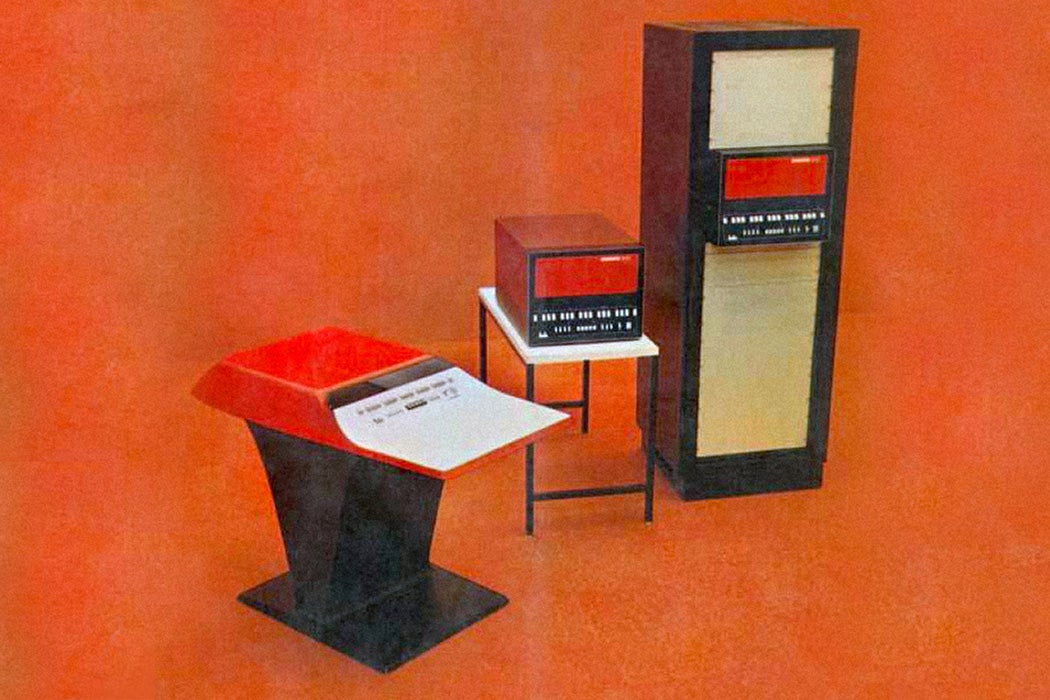What would anybody even do with a computer in the home, wondered computer engineers in the late 1960s as they scratched their New Frontier buzz-cuts. Between 1968 and 1972, a hundred companies launched new minicomputer products, superseding mainframes for many uses—all of them business, industrial, and scientific.
A computer in the house was an exotic idea. For one thing, where would you even put it? Minicomputers were plain boxes that fitted into standard electronic rack systems. But in 1968, one version of Data General’s NOVA minicomputer came with a stand for the top of a desk. Honeywell followed with three different iterations of its successful H316 model: standard rack-mounted, desk-top mount, and Jetsons-sleek floor pedestal mount. Historian of design Paul Atkinson backgrounds Honeywell’s radical new look. Industrial designer Don Kelemen, “responding to a marketing brief to add ‘a “wow” factor to introduce the H316 to the world,’…created the unique form of the pedestal version by encasing the components of the standard version in a fiberglass shell—a first in the computer industry.”
The H316 pedestal model, “futuristically styled, red, white, and black,” looked like something out of Star Trek or, perhaps more apropos, 2001: A Space Odyssey, for Honeywell had worked closely with director Stanley Kubrick. This was the model presented in the upscale retailer Nieman Marcus’s 1969 Christmas Book as the “Honeywell Kitchen Computer.” It was advertised as a recipe selector.
“If she can only cook as well as Honeywell can compute,” began the ad copy (in the condescending sexism of the day).The price tag? $10,600. To put this in context, Atkinson notes this was more than the average annual income ($8,500) but less than the average cost of a new house ($15,500).
Oh, and the would-be kitchen contender weighed in at 115 pounds.
The Honeywell Kitchen Computer is sometimes used as a case study of early computer failures. Atkinson begs to differ. It wasn’t really a product to begin with, so the handful of sales were immaterial. He argues it was a kind of early vaporware or conceptual hype, a “non-product” idea. Mock-ups were made for marketing purposes, and the one shown at Nieman Marcus’s press conference—yes, they had press conferences to showcase that year’s catalog gimmick—was jury-rigged with a pine frame supporting the fiberglass.
Nieman Marcus had been grabbing media attention with big-ticket fantasy offerings in its Christmas Book since 1960, and attention is precisely what these marketing escapades were designed for. In the words of Stanley Marcus, who picked the ideas himself, the company aimed for “concepts which have a degree of credibility (however faint), are not hackneyed, and will evoke the question ‘I wonder if they sell any?’”
Beginning with his-and-her Beechcraft airplanes, subsequent Christmas Books presented a two-person submarine, Egyptian mummy cases, “a real Black Angus Bull with a sterling silver barbecue cart, authentic Chinese Junks, and a made-to-order Noah’s Ark.”
Honeywell’s menu-selecting computer was 1969’s buzz-worthy bait. The whole thing was “a deliberate attention-getting device, a successful marketing ploy, or even just a bit of fun,” writes Atkinson. But things didn’t end there, he notes. “The design of the computer had significant impact, even if it was purely the idea of the product that was being consumed.”
Weekly Newsletter
Kelemen remembered that “we built the computer as a marketing tool, but to our dismay we received several orders.” Around twenty shells and frames were made, filled with H316 parts. At least one was purchased by a college. The Computer History Museum has one. It wasn’t completely vaporous.
And it wasn’t only the design that was influential. Gordon Bell, an engineer at Digital Equipment Corporation, was inspired to think about what a computer could do in the home after deciding the Honeywell Kitchen Computer itself would be “useless” for recipes. Here, in Atkinson’s paraphrase, is what a DEC internal memorandum brainstormed for uses of a domestic computer in December 1969:
teaching children, self-improvement for adults, for home-based businesses, playing games and home organization—budgeting, filing and as a calendar. In the future, a computer in the home could interactively control heating, air conditioning, lighting, burglar alarms, dishwashers and music system. One day a computer could play complex games such as chess, send and print letters over a network…
Bell wasn’t wrong.







